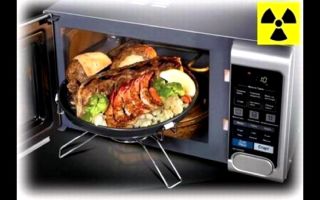Content
- 1 The history of the creation of the microwave
- 2 How does a microwave oven work
- 3 Is the microwave good for you?
- 4 Microwave food: benefit or harm
- 5 Is the microwave harmful to human health?
- 6 The benefits and harms of a microwave oven according to scientists
- 7 Is it possible to reheat food in the microwave for a child
- 8 How to test a microwave for radiation
- 9 How to use the microwave correctly
- 10 Microwave utensils
- 11 How to choose a microwave for home
- 12 Conclusion
The benefits and harms of a microwave oven lie in the microwaves that it emits during operation. Electromagnetic waves are emitted by all objects powered by mains voltage. Refrigerators and microwave ovens are considered the most powerful in terms of radiation.
Scientists are divided on the dangers of a microwave oven.
The history of the creation of the microwave
The microwave was invented in 1946. An American scientist named Percy Spencer has worked on microwave radars. He once experimented with a magnetron. After the experiment, I found a melted piece of chocolate in my pocket.
He repeated the experiment on food, placing a sandwich on the magnetron. The product has warmed up. In 1947 he patented his invention. Discovered useful properties of electromagnetic radiation. This is a quick reheat of food.
The first microwaves were released in the same year. They did not enter mass production, but were used to defrost food in soldiers' canteens.
The first household stoves weighed 350 kg and reached 1.8 meters in height. With a power of up to 3000 watts, they worked on water cooling.
For the first time a household microwave oven in 1955 was released by the Tappan Company. The demand for such ovens was weak. In the USSR, microwave ovens began to be produced after 1980 by the companies "ZIL", "Electropribor".
How does a microwave oven work
Microwaves use the beneficial properties of the 2450 MHz wave frequency, which is set by international standards. It does not interfere with the operation of other microwave-powered devices.
It is known from the physics course that electromagnetic waves tend to propagate at a speed of 300 thousand km / s. Based on the data, we can calculate that the microwave wavelength is 12.25 cm. This will be the first refutation of the theory that the waves from the microwave oven hit 1.5 km, irradiating everything in the path.
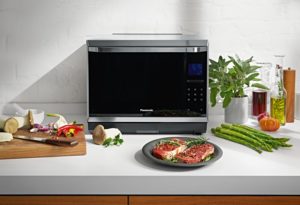
Now about the waves that affect the heating of food.
Food, be it pieces of meat, fish, contains dipole molecules. Food molecules have a positive charge at one end and a negative charge at the other. When an electric field acts on them, they line up strictly in the direction of the field lines of force. When the poles of an electric field change, dipole molecules change poles.
1 MHz is a million oscillations per second. That is, dipole molecules, like the electromagnetic field in a microwave, will change their poles so many times. At a microwave frequency of 2450 MHz, the microwave oven is switched on, the molecules endlessly change poles, rub against each other. Heating occurs due to friction.
Is the microwave good for you?
Microwave ovens have useful properties that give them huge advantages over gas stoves:
- reheat food quickly;
- cook, defrost semi-finished products;
- small size;
- ease of use;
- safety for children.
It is interesting that radiation of this frequency is used in the treatment of human diseases, helping:
- heal wounds;
- give an anti-inflammatory effect.
In addition, microwaves do not have any radioactive effect on a person who is near the device. Proponents that the microwave oven is not hazardous to health argue that the radiation generated in it cannot escape due to the shell in which the oven is clothed.
Scientists also differ on the benefits and dangers of heating food in the microwave.
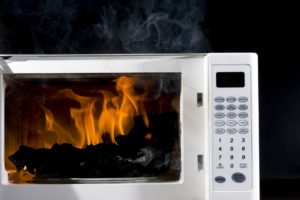
Microwave food: benefit or harm
Before talking about the dangers and health benefits of a microwave oven, about the properties of food cooked in it, you need to understand how food is heated.
On a regular fire, food is heated from the bottom. In the microwave, it is heated on both sides. The movement of molecules becomes chaotic with prolonged heating.
With strong heating, vitamins are destroyed, proteins are denatured. Protein denaturation does not harm the body: it is the purpose of heat treatment.
Some bacteria, for example Salmonella, which has high vitality properties, are not killed at heating temperatures, which rarely reach 100 degrees.
The harm of heating in the microwave will be done to health only if the food is in plastic. When temperatures rise, the properties of plastic to release chemicals into the atmosphere can be harmful if ingested.
Is the microwave harmful to human health?
The beneficial properties of the microwave have been listed earlier. But there are some signs that indicate the properties of the stove, which have a negative effect on the body.
Influence on blood composition
Electromagnetic waves affect the human body through cooking and eating food from the microwave. They change the composition of the blood:
- reducing hemoglobin;
- increasing the number of white blood cells;
- changing the composition of "good" high density cholesterol (HDL) to "bad" low density (LDL), which promotes the formation of plaque in the vessels.
Studies have shown the harm of microwave radiation to milk mixtures heated in them. Electromagnetic vibrations change the milk composition. L-proline acids are converted to d-isomers. The latter are toxic, destroy the nervous system, and are toxic to the kidneys.
Effect on protein
Radiation deforms the protein and changes its properties. Meat after cooking in a microwave oven contains carcinogens. Certain dairy products and cereals also become rich in carcinogens when heated.
Microwave radiation denatures the protein. Leads to loss of solubility and hydrophilicity.
Weakening the body
When food is heated in the microwave, the cell membrane of the food pieces is weakened. Food is easily contaminated with viruses, fungi, and other microorganisms. This can lead to the formation of rot, which is harmful to our body.
When exposed to a person, radiation suppresses the natural mechanism of cell repair, suppressing the immune system. Therefore, you should not stay for a long time near working microwave ovens.
The harm that a person receives from food from a microwave does not act instantly. It can accumulate in the body for up to fifteen years, and then manifest itself in various diseases.
The benefits and harms of a microwave oven according to scientists
Opinions about the benefits of eating from a microwave among scientists diverged: some consider the data on the dangers of a microwave unproven, others closely study all the harmful properties of the radiation of the oven. For example, the journal Earthletter provides scientific evidence about the harmful properties of the microwave, according to research conducted in 1991:
- deterioration in the quality of food;
- transformation of amino acids and other compounds into carcinogenic and toxic substances;
- reduction in the nutritional value of root crops.
Russian scientists also found that the nutritional value of food is reduced by 80%. According to scientists of the Russian Federation, heating food with a microwave oven, defrosting meat with it leads to the following problems:
- violation of the composition of the blood and the work of the human lymphatic system;
- violation of the stability of cell membranes;
- slowing down the flow of signals from nerves to the brain;
- breakdown of nerve cells, leading to a loss of energy in the central and autonomic nervous system.
The researchers note that microwave-cooked food has a low pH, which upsets the acid-base balance towards acidification of the internal environment of the body.
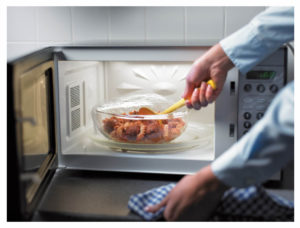
Is it possible to reheat food in the microwave for a child
Rapid heating of baby food products outside the microwave can destroy all of its useful and essential vitamins and minerals for the baby. Milk formulas, which are similar in composition to mother's breast milk, are best not exposed to electromagnetic radiation, which destroys the structure of the formula and destroys vitamins.
Reasonable precautions must be taken considering that:
- the final conclusion of scientists that the microwave oven causes cancer is not done;
- electromagnetic waves make food molecules rotate at a high speed, therefore it is recommended to heat baby food correctly: do not turn it on at full power and reheat in short stages: heat it up, stir it and reheat it;
- too frequent use of the microwave is not recommended.
How to test a microwave for radiation
There will be no benefit from microwave ovens if there are gaps in the protective shell of the device, which will undoubtedly harm a burn.
Radiation escaping from the enclosure of the device can seriously burn the nearby owner. Therefore, microwave ovens that have been in service for more than three years should be tested for radiation. And it's better to say goodbye to microwave ovens over 9 years old.
Radiation test steps (this can be done at home):
- Find a fluorescent or neon "NE-2" lamp. Special home tests can be used.
- Put out the lights everywhere. Test at night.
- Put a glass of water inside and turn it on for 2 minutes.
- During operation, drive a light bulb along the body of the device at a distance of 5 centimeters above the surface.
- When radiation penetrates through the body, the luminescent dump will glow, while the neon one will light up with a bright light.
How to use the microwave correctly
People don't think about how to use electrical appliances correctly. But their lives, as well as households and neighbors, depend on this. Therefore, it is useful to follow the safety rules before using the microwave:
- Read the instructions for using the microwave oven.
- Before turning on the purchased stove, install it on level ground.
- Connect to the network. Place only the dishes recommended by the instructions.
- Unplug the appliance before leaving home.
- The useful life of microwaves: expensive ones will last from five to 10 years, cheap ones - up to 3 years.
- Clean the inside and outside of the microwave on a regular basis, after disconnecting it from the power supply.
- Wash with warm water and liquid soap.
- Switch on only after natural drying.
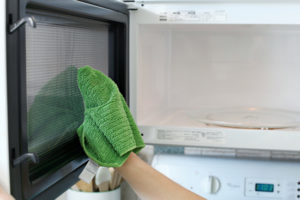
Microwave utensils
Not all utensils are microwave-safe. Metal dishes do not allow waves to pass through, which can damage the oven.
Cookware that is not suitable for microwave ovens:
- Cast iron, copper, brass. Spark discharges generated when electric waves strike a metal surface will damage the interior of the microwave;
- Porcelain or glass with a pattern.The paint contains impurities of metals, therefore, electromagnetic waves, touching the drawing, will create sparks, which can also damage the furnace;
- Crystal also contains particles of lead, silver, its surface is heterogeneous, which can lead to an explosion of dishes inside the microwave;
- Plastic and cardboard. Waxed cardboard does not transmit electromagnetic waves;
- Aluminum cookware.
The dishes recommended for use in the microwave:
- porcelain without a pattern;
- faience, no pattern;
- ceramic, if covered with glaze.
How to choose a microwave for home
When choosing a microwave for your home, you need to decide on the volume:
- ovens up to 20 liters are suitable for defrosting, heating food;
- from 20 to 25 liters - for a family of about 4 people: a grill function is provided in such an oven;
- from 25 liters are suitable for large families.
The next guideline should be power:
- less than 800 watts is suitable for heating food;
- over 800 watts up to 1500 watts - for grilling, cooking.
Microwave control can be push-button, touch, mechanical. Mechanical is the easiest way to control the oven.
In addition to heating and defrosting food in the microwave, various functions can be present:
- protection from children;
- steam cleaning;
- removal of odors;
- keeping food warm.
The choice depends on the wishes and needs of the future owner.
Conclusion
The benefits and harms of a microwave oven is a controversial topic due to the lack of an official conclusion on the health risks of the device. From the available information, we can conclude that the microwave is conditionally useful for quickly heating food. It has been proven that cooking certain foods in microwave ovens can harm the body. Therefore, the choice in favor of microwave cooking lies with the consumer.

